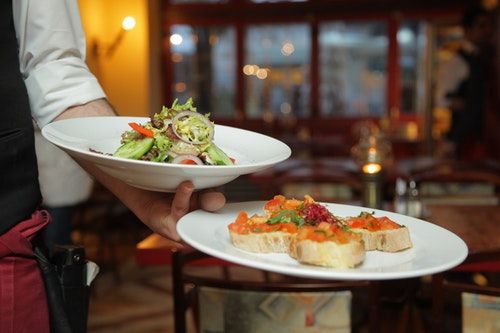Let's talk! Browse our offer and let us help you create your own budget.
How to Order Food in a Spanish Restaurant
Ordering food abroad can be tricky sometimes. Eating out is often one of the first things people do when they travel, so at that early stage you may not know the expressions and vocabulary to communicate properly.
Don’t worry! Here you’ll find everything you need to know to get by fluently and order your food in Spanish without batting an eye.
You can also read this post in Spanish.
How to get a table
The most important thing if you want to sit down to eat is to get a table. You can call the restaurant in advance to book, or just go in person and try your luck. If you are with a large group, we recommend you make a reservation ahead of time to ensure you can get a table.
Remember that meal times in Spain may be different from what you’re used to. (How does dinner at 10 p.m. sound?)
Here are some expressions you can use as an example to get a table:
Cliente (customer) —Buenos días/ buenas tardes/ buenas noches, ¿para comer / cenar?
(Good morning/afternoon/evening. For lunch/dinner?)
Camarero (waiter) —¡Hola! Claro, ¿tienen reserva? / ¿cuántos son?
(Hello! Of course, do you have a reservation? How many people?
Cliente —Sí, tengo una reserva a nombre del señor Smith. / No, solo somos dos personas
(Yes, I have a reservation for Mr. Smith. / No, we need a table for two.)
Camarero —Por aquí, por favor
(Right this way, please).
Cliente— ¡Gracias! (Thank you!).
Frequently Asked Questions about Spanish menus
Although you can often find an English version of the menu, it’s good to know what to order and how to do it so that no one has an unpleasant surprise.
There’s one question almost always comes up if you order meat (especially beef). The waiter will usually ask you how you’d like your meat, or as Spanish would say,
¿Cómo quiere el punto de la carne? / ¿Cómo quiere la carne?
You can answer with poco hecho (rare), al punto (medium), and “muy hecho / pasado” (well done). If they don’t ask, don’t hesitate to tell them anyway (e.g. “me gustaría tomar la carne al punto.”)
In Spain, it is also very common to ask what the specialty is. You can say, for example, “¿Qué nos recomienda tomar?” (What do you recommend) or “¿Cuál es la especialidad de la casa?” (What is the house’s specialty?)
If you need to know the specific ingredients of a recipe, you could ask something like this: “¿Este plato lleva algo de marisco / gluten / cebolla…?” (“Does this dish contain seafood/gluten/onion?”), “Soy alérgico al huevo, ¿me puedes recomendar algo que no lleve?” (“I’m allergic to eggs, could you recommend something for me?”).
Also, don’t forget about the menú del día. It is a set-price menu usually offered Monday to Friday at midday. It generally consists of a first and second course and a dessert or coffee, and a drink and some bread are usually included, too.
How to order food in Spanish
When the moment to order comes, the confusion arises. This may occur since protocol varies from one culture to another and depends on the different customs of each country.
Here are some useful expressions in Spanish to use in restaurants:
Camarero (waiter) —¿Ya saben lo que van a tomar? / ¿Qué quieren tomar? (Are you ready to order? / What would you like to order?).
Cliente (customer)—Sí. De primero tomaremos la crema de verduras y una ensalada mixta. (Yes. We’ll have the creamy vegetable soup and a salad to start.)
Camarero —Perfecto. ¿Y de segundo? (Perfect. What about the main course?)
Cliente —De segundo tomaremos solomillo de ternera. (We’ll have the sirloin steak.)
Camarero —¿Cómo prefieren la carne? (How would you like the meat?)
Cliente —Al punto y muy hecha, por favor. (Medium and well done, please.)
Camarero —¿Qué quieren para beber? (Anything to drink?)
Cliente —Para beber, una botella de agua y una Coca-Cola, por favor. (Sparkling water and a Coke, please.)
Camarero —¿El agua fría o del tiempo? (Do you want the water cold or room temperature?)
Cliente —Fría, por favor (Cold, please.)
Camarero —¿Desean algo más? (Anything else?)
Cliente —Así está bien de momento, gracias. (That’s all for now, thanks).

How to order dessert and coffee in Spanish
As a rule, the waiter will ask if you are going to have dessert or coffee when you finish the second course:
Camarero (waiter) —¿Desean algo de postre o café? (Would you like any coffee or dessert?).
Cliente (customer) —Sí, por favor ¿podría traernos la carta de postres? (Yes, please. Could we see the dessert menu?)
Camarero —¡Claro! Aquí tienen. (Sure! Here you go.)
Cliente —Probaremos el arroz con leche y la tarta de chocolate. (We’ll have the rice pudding and a piece of the chocolate cake).
You might also want to have a coffee or tea. In Spain, the most popular options are café cortado (espresso with a small amount of milk), café solo (espresso, which you can ask for “con hielo” or with ice in the summertime), and poleo menta (mint tea). Café con leche is usually enjoyed in the morning, but you can order it any time you want.
Asking for the check in Spanish
In some countries it’s common for waiters to bring the check automatically when customers finish their meal, but Spain is not one of them. Spaniards like to take it easy and enjoy what they call la sobremesa. This means people like to chat while they have a coffee or even a digestif. But, if you’re in a hurry,
Cliente (customer) —¿Me/Nos puede traer la cuenta, por favor? (Could you bring me/us the check, please?).
Camarero (waiter) —¿Van a pagar en efectivo o con tarjeta? (Cash or card?)
Cliente —Con tarjeta. ¿Me puede traer el datáfono? (Card. Could you bring the card reader?)
*Note that in Spain when you pay with card, the waiter will usually bring a wireless card reader to the table.
Camarero —¡Por supuesto! (Sure!)
By the way, tips aren’t mandatory in Spain, but they are very common. The better the service, the higher the tip should be.
Useful Spanish phrases to use in a restaurant
To finish, we propose some helpful language you might want to use at the restaurant:
- La comida está muy fría/caliente – The food is too cold/hot
- ¡Felicite al cocinero! – My compliments to the chef!
- ¿Dónde están los aseos / el baño / los servicios / los lavabos, por favor? – Where is the bathroom, please?
- No estoy satisfecho con el servicio. ¿Tenéis hojas de reclamaciones para clientes? —I’m not satisfied with the service. Are there any complaint sheets available for customers?
¡Que aproveche! (Enjoy your meal!)

